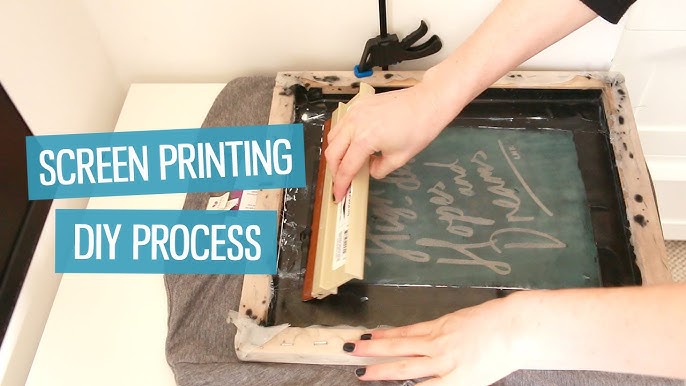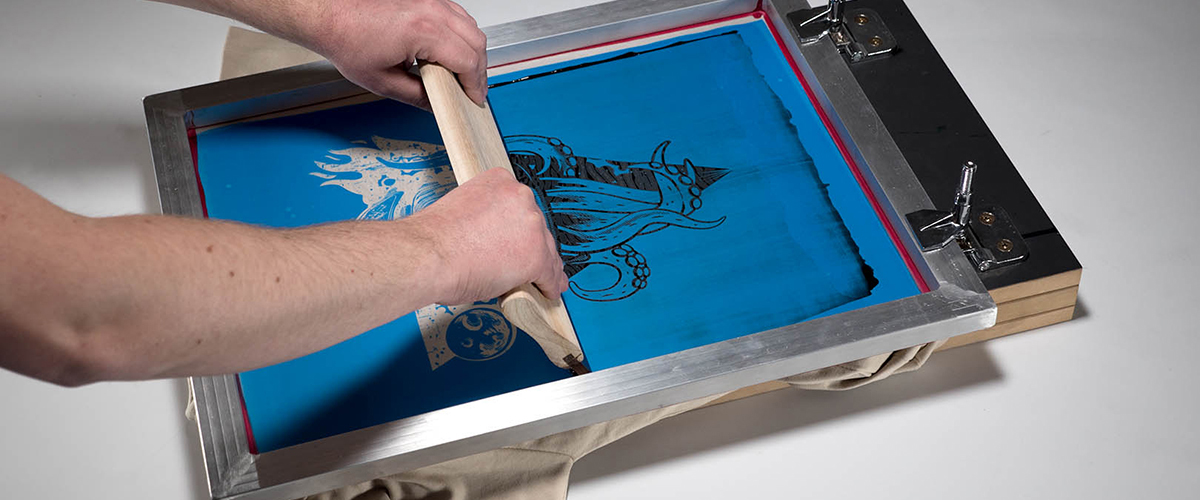ChatGPT said: How to get quick answers through 10:9 Design contact for your next order
Discover the Different Kinds of Screen Printing Techniques for Your Following Job
Screen printing supplies a varied variety of techniques that can enhance any kind of innovative project. From conventional methods like serigraphy to modern-day technologies such as direct-to-garment printing, each strategy has its unique benefits. Specialty options, consisting of metallic and green inks, present also more opportunities. Understanding these methods can substantially impact the final outcome. The challenge exists in picking the most ideal approach for particular requirements and wanted effects. What aspects should one think about?

The Fundamentals of Screen Printing
Although screen printing might appear complicated, it is essentially a simple process that includes moving ink via a mesh screen onto numerous surfaces. The strategy begins with the production of a pattern, which specifies the style to be published. This stencil is connected to a mesh screen, normally made from polyester or nylon. When the pattern remains in location, ink is related to the screen and pressed with the mesh using a squeegee, causing the wanted pattern being published on the underlying product.
Screen printing can be carried out on a vast array of substrates, including material, plastic, and paper, making it a functional selection for various projects. The procedure enables for elaborate layouts and dynamic colors, making it popular in industries such as art, fashion, and marketing. Understanding these fundamentals outfits individuals with the fundamental knowledge needed to check out more advanced techniques in screen printing.
Typical Screen Printing Techniques
Standard screen printing techniques have actually been employed for centuries, preserving the workmanship and virtuosity of this method. This strategy utilizes a mesh screen to move ink onto a substratum, such as material or paper, enabling for lively and durable styles. The procedure starts with developing a pattern, which obstructs specific areas of the screen to regulate where the ink will be applied.
One prominent method is serigraphy, usually utilized for creative prints and restricted editions. One more is the usage of water-based inks, which are eco-friendly and provide a soft feeling on fabrics - 10:9 Design Screen Printing Texas. Additionally, conventional methods can include hand-operated printing, where artisans apply ink with a squeegee, making certain precision and focus to information
These techniques stay valued in the sector for their responsive top quality and the distinct textures they create, interesting both creators and consumers that value the heritage of screen printing.
Digital Screen Printing Innovations
As the need for faster production and customization in the printing industry has surged, digital screen printing technologies have actually emerged as a game-changer. This innovation blends traditional screen printing techniques with digital procedures, enabling fast prototyping and complex layouts that were formerly tough to achieve. One significant advancement is the introduction of direct-to-garment (DTG) printing, which helps with high-quality, full-color prints on numerous textiles without the demand for displays. Furthermore, improvements in ink solutions have actually led to green choices that preserve lively shades while minimizing ecological influence. Using automated systems additionally improves production, reducing labor costs and enhancing accuracy. These technologies not just deal with tiny batch orders and individualized styles however likewise permit quicker turnaround times, making them optimal for businesses concentrated on meeting consumer needs in a hectic market. Digital screen printing, consequently, stands for an important advancement in the domain of printing methods.
Specialized Screen Printing Techniques
Checking out specialty screen printing approaches exposes a diverse array of strategies that push the limits of imagination and capability in the printing market. Amongst these, glow-in-the-dark inks give an one-of-a-kind aesthetic result, making styles come active in low-light conditions. Metal inks, known for their sparkling surface, add a touch of high-end to published materials. Another cutting-edge technique is discharge printing, which removes color from the material as opposed to adding ink, leading to a soft, vintage feeling. High-density printing creates an increased texture on the surface area, enhancing tactile involvement. Additionally, water-based inks are getting popularity for their dynamic colors and lowered ecological impact. Each of these specialized methods caters to particular design requirements, enabling brand names and musicians to develop standout items that reverberate with their target markets. By leveraging these techniques, services can boost their screen printing tasks to new elevations, making sure memorable impressions.
Eco-Friendly Screen Printing Options
Eco-friendly screen printing alternatives are getting traction as the industry shifts in the direction of sustainability. Lasting ink selections and the use of naturally degradable materials are vital parts in lowering the environmental effect of the printing procedure. By adopting these practices, screen printers can add to a more sustainable future while preserving high-grade results.
Sustainable Ink Options

Biodegradable Products Usage
As the screen printing industry develops, the unification of naturally degradable products is becoming significantly important for environmentally mindful practices. Suppliers and designers are now exploring inks and substrates made from natural, eco-friendly resources that decay much more efficiently than typical equivalents. These naturally degradable alternatives lower plastic waste and minimize environmental impact, aligning with the growing need for lasting products.
Usual examples include water-based inks and natural cotton materials, both of which minimize unsafe chemicals and advertise eco-friendliness. Brand names that adopt these materials often enhance their market appeal, bring in customers that focus on sustainability. As recognition of environmental issues remains to increase, the change towards eco-friendly materials in screen printing is most likely to gain energy, cultivating a greener sector standard.
Picking the Right Strategy for Your Job
Just how can one figure out one of the most ideal screen printing method for a particular project? The decision pivots on a number of factors, consisting of the material to be printed on, the intricacy of the design, and the wanted manufacturing volume - 10:9 Design reviews. Direct-to-garment printing is ideal for intricate styles with various colors, while conventional screen printing succeeds for bigger runs of simpler graphics.
Furthermore, consideration of the end-use of the printed product is important. For outside applications, techniques that supply resilience and weather resistance, such as plastisol ink, may be chosen. On the other hand, environmentally-conscious jobs may take advantage of water-based inks or biodegradable products.
Inevitably, recognizing the job's special requirements permits for an informed option, guaranteeing both visual charm and useful long life. By examining design complexity, product compatibility, and manufacturing range, one can effectively select the most suitable screen printing technique to fulfill their task's goals.
Frequently Asked Questions
What Is the Background of Screen Printing?
Screen printing originated in ancient China around 1000 ADVERTISEMENT, evolving via Japan and Europe. By the 20th century, it came to be preferred in business art and style, changing just how layouts were created and distributed around the world.

How Do I Prepare Artwork for Screen Printing?
To prepare artwork for screen printing, one must ensure high resolution, utilize an ideal shade setting, create separate layers for each shade, and convert message to outlines, ensuring compatibility with the printing process and preferred outcome.
What Materials Are Finest for Screen Printing?
The very best products for screen printing consist of high-quality inks, long lasting displays, and appropriate substrates like cotton, polyester, or blends. Furthermore, making use of appropriate emulsion and mops can enhance the printing procedure and last results.
Can I Evaluate Publish in your home?
Yes, screen printing at home is feasible. With the best materials, setup, and methods, individuals can create top notch prints. Nevertheless, mindful consideration of work space and devices is essential for successful outcomes.

What Are Common Errors in Screen Printing?
Common mistakes in screen printing include incorrect exposure times, inadequate ink uniformity, imbalance of screens, not enough cleaning of products, and neglecting to test prints. These mistakes can jeopardize the high quality and accuracy of the end product.
Screen printing might appear complex, it is essentially a straightforward process that entails transferring ink via a mesh screen onto different surfaces. As the need for faster production and modification in the printing market has actually surged, electronic screen printing technologies have arised as a game-changer. Discovering specialty screen printing more info techniques exposes a varied array of techniques that press the borders of imagination and performance in the printing market. The best products for screen printing consist of high-quality inks, long lasting displays, and suitable substrates like cotton, polyester, or blends (10:9 Design near me). Common blunders in screen printing include incorrect direct exposure times, poor ink uniformity, misalignment of screens, inadequate cleaning of products, and ignoring to test prints